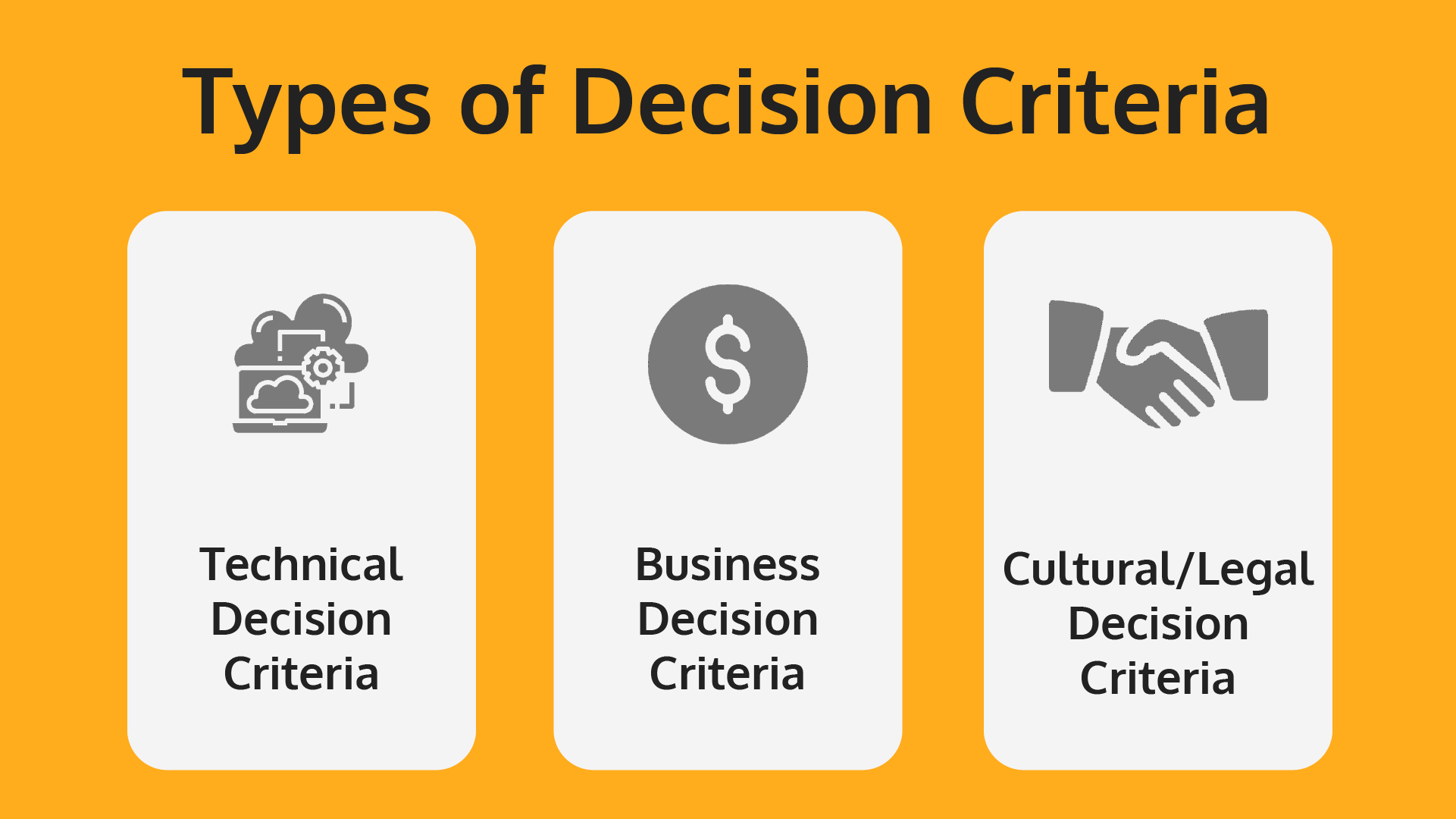What is Decision Criteria & How to Influence Them in Your Favor to Close More Deals | MEDDIC | MEDDICC | MEDDPICC
Decision Criteria (Dc) is a component of the MEDDICC sales methodology. It is fundamental to how organizations collaboratively decide if and which solution they are going to purchase in order to solve a particular pain or serve an initiative.
Nowadays, decisions are not just made by individuals or departments, but by various teams and stakeholders who all have different points of views and can shape the decision criteria. According to a CEB study, more than 5 decision makers are needed for B2B solutions. At times, there can even be 6-10 stakeholders involved in making a decision.
There are 3 main types of Decision Criteria:
It’s crucial for salespeople to uncover the different Decision Criteria of their prospect early in the sales process in order to:
- Determine if the opportunity matches their offering and if it’s worth pursuing
- Get the chance to influence the criteria to fit their offering and unique differentiators
- Consolidate and lock the prospect down to a common Decision Criteria in order to lead to a joint decision across departments and hierarchies.

Ideally, all of this should happen prior to a formal process such as a Request For Proposal (RFP) – but more on this later.
Let’s first take a deeper dive into the different types of criteria.
1. Technical Decision Criteria
The most common and communicated Decision Criteria is the Technical Decision Criteria. This is where the client defines and assesses the “fit for purpose” of your solution. In other words, how a potential solution must look like to fit the current infrastructure and organization, and how easily it can be implemented, integrated and be up and running.
Typically, your prospects will have a catalogue with clear requirements and even associated metrics.

The types of profiles you might interact with during the Technical Decision Criteria phase are Project Leads, Architects, Product Owners, Heads of Infrastructure, Enterprise Architects, Operations, Heads of Security etc.
Meeting these more technically and operationally oriented people not only allows you to discover their technical criteria, but also gives you the opportunity to search for technical Champions who have a personal interest in solving problems together with you.
While the Technical Decision Criteria is crucial for success, experienced salespeople know that business decisions are being made somewhere else. These business decisions will have a different set of Decision Criteria altogether.
2. Business Decision Criteria
While the Technical Decision Criteria paves the way for a solution, the Business Decision Criteria determines the funding.
The decision makers for the Business Decision Criteria are usually higher up in the chain of command and deal with the business strategy and financials of the company/department. They are not so much interested in the technical aspects, but rather how the solution will fit with their business initiatives and financial criteria around growth and expansion, cost reduction or restructuring to better serve their clients.

Over here, the roles you will usually encounter are C-level executives like the CEO, CIO, CFO. CISO, COO, as well as VP, SVP, Heads of Business Units or customer-facing services.
As these people are linked to the business, we call them Economic Buyers. Meeting the Economic Buyers in person is crucial as it allows you to confirm their “criteria for success”, which oftentimes are very different from the Technical Decision Criteria. Hence, meeting them will enable you to understand the bigger picture.
Typical Business Decision Criteria involve:
- Cost savings – Metrics like reduced FTE and cost per client
- Increase in sales or market share
- Return on investment, cost vs. return for time period (eg. 18 months), or a factor of 5 years (eg. 5x)
- Time to market
- Risk mitigation & compliance
As most Economic Buyers are not technically trained, they depend on their technical subject matter experts (ie. Technical Champions), to gain a better understanding of the technical aspects of the project and drive them from there. Thus, it is important to understand who they depend on as these Technical Champions will grant you access to the Economic Buyers.
3. Cultural/Legal Decision Criteria
This criteria is often vague and not formally defined. However, it is of utmost importance when closing large deals. It is built around the trust and confidence in you and your company to help them succeed.

Cultural Decision Criteria involve:
- Solution-fit to company size
- Vertical and/or direction we are heading to
- Financial stability
- Size
- Power
- Trust in you and your company.
- Questions your prospect will ask:
- Are they capable of doing it?
- Can we trust them?
- Will they still be around after the sale for support when troubles arise?
- Questions your prospect will ask:
Legal Decision Criteria involve:
- Ease of doing business
- Acceptance of paperwork
You must discover these criteria to make sure that the stakeholders have the answers that will build trust and faith in you, your company and offering.
All the different aspects of the Technical, Business, Cultural and Legal Decision Criteria and your ability to match them and check the boxes will strengthen your position to close the deal.
But what happens if you can’t meet all the Decision Criteria? This is when great salespeople come into play with creative positioning in order to influence the Decision Criteria.
Discovering vs. Influencing the Decision Criteria
There are different levels of freedom and ability when it comes to influencing the Decision Criteria. They depend on:
- How early in the customer’s buying cycle you’re in. The earlier you get to know the initiative, the greater the chance you’ll have to co-work and shape the Decision Criteria.
- Existing frame contracts and relations with other vendors which dictate your influence.
- Your prospect’s maturity on the topic, especially when you enter the game late.
- The type and size of companies, that might rule interactions and exchanges with the stakeholders (ie. Federal or large Enterprises vs SMB).
However, keep in mind that you and your team are subject matter experts in the industry and can value-add to the Decision Criteria based on industry best practices and experience from successful projects in the past.
This is where you have a good chance to shape and challenge the client’s Decision Criteria by educating them on things they haven’t considered before and highlight your strengths and unique differentiators. ie. This is your chance to build your reputation and change the game!
How to Influence the Decision Criteria
My sales team was excited to answer the RFP because we were THE market leader in the space and the bank would be a great new logo addition. However, during the forecast meeting, the sales engineers were worried about the Decision Criteria listed in the RFP.
Furthermore, Andy, our lead engineer, knew about the bank’s history of purchasing CMDBs and failing to successfully implement them. He further explained: “They were more focused on deciding a tool rather than the actual process of filling the DB with real-time data. They will fail again, if they don’t think about updating the DB, which basically means integrating all of their IT processes around buying, installing and retiring IT related items.” Andy recommended that we pull out of answering the RFP as the CMDB criteria was the smallest part in the whole equation. Moreover, the risk of losing our reputation and burning a new logo from the start was just not worth it.
While my sales team was upset by Andy’s harsh words, it all made sense to me.
I was even thrilled because we could now demonstrate our subject matter expertise and lead the client to success. I asked the salespeople on the account to contact the client so that we could share our views in hopes of reshaping the RFP – to help them succeed. The only issue was that the client’s project team did not want to consider our input at all.
After multiple unsuccessful attempts at trying to convince the various teams at the bank, I decided to step back and informed the client that we would not be able to answer the RFP. The sales team was upset, as I had let the chance to win this prestigious new logo go. However, I was convinced that we did the right thing.
A week later, I got a call from the CIO of the bank, who asked me why BMC, as market leader, would not participate in the RFP. I then explained the reasoning and our best practice approach that we adopt around CMDBs. After a short while, the CIO offered an in-person meeting together with the core team, where we were able to explain our plan to propel the bank to success.
6 months later, we closed a deal valued at $US 4.5 Mio deal around IT Service Management. This happened because we were able to interact directly with the CIO, who has a business responsibility and was more concerned with the Business Decision Criteria, which gave us the opportunity to demonstrate our expertise in this field and how our solution would be beneficial for his criteria set. In addition, the CIO in this case was also the Economic Buyer. Once the CIO was bought in, he was able to be our Champion to drive this deal to closure.
To summarize, we need to be aware of the various aspects of the prospects’ Decision Criteria and try to match them with our capabilities. If there are criteria that we can’t fulfil, we need to investigate the underlying cause for this criteria and propose workarounds. In addition, if an important criteria that you serve is missing, we need to challenge the client and showcase our knowledge on the subject at hand based on our proven track record.







Leave a Reply
Want to join the discussion?Feel free to contribute!